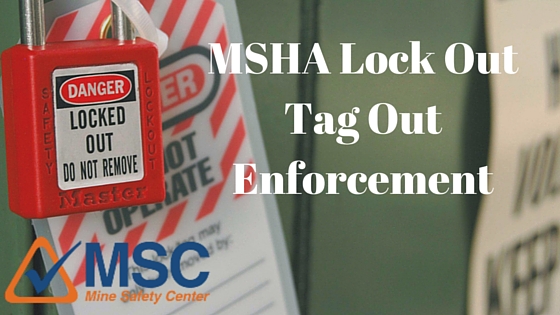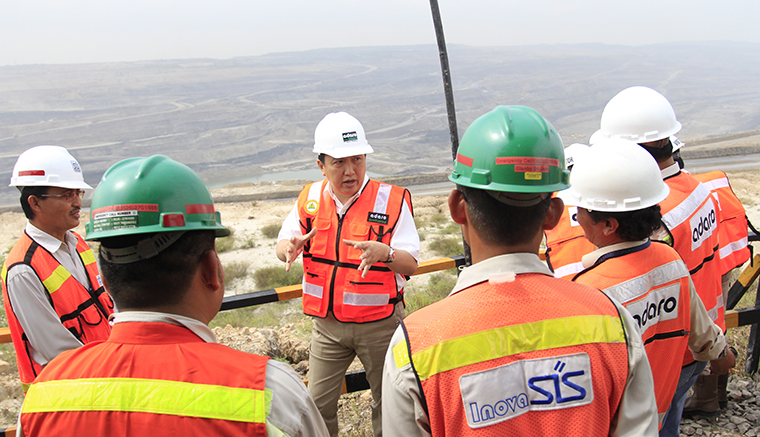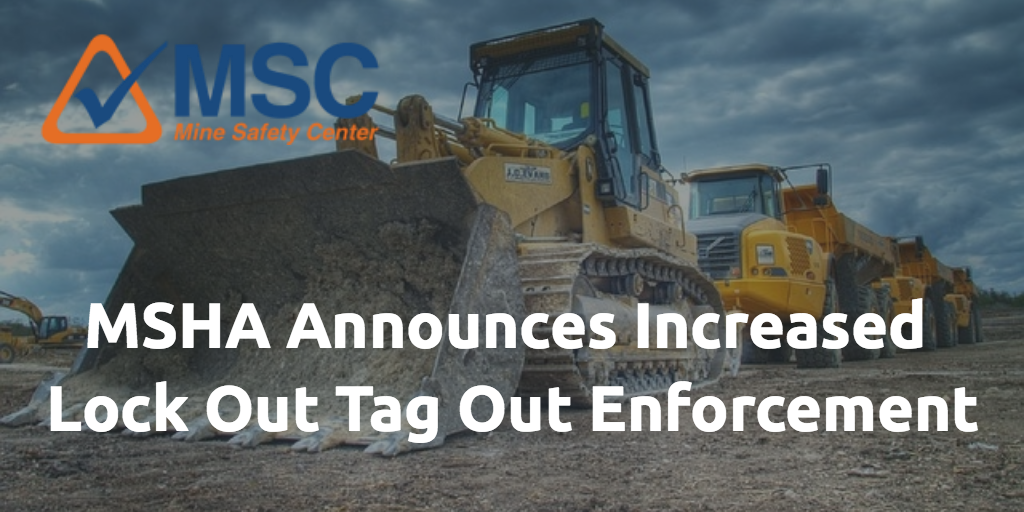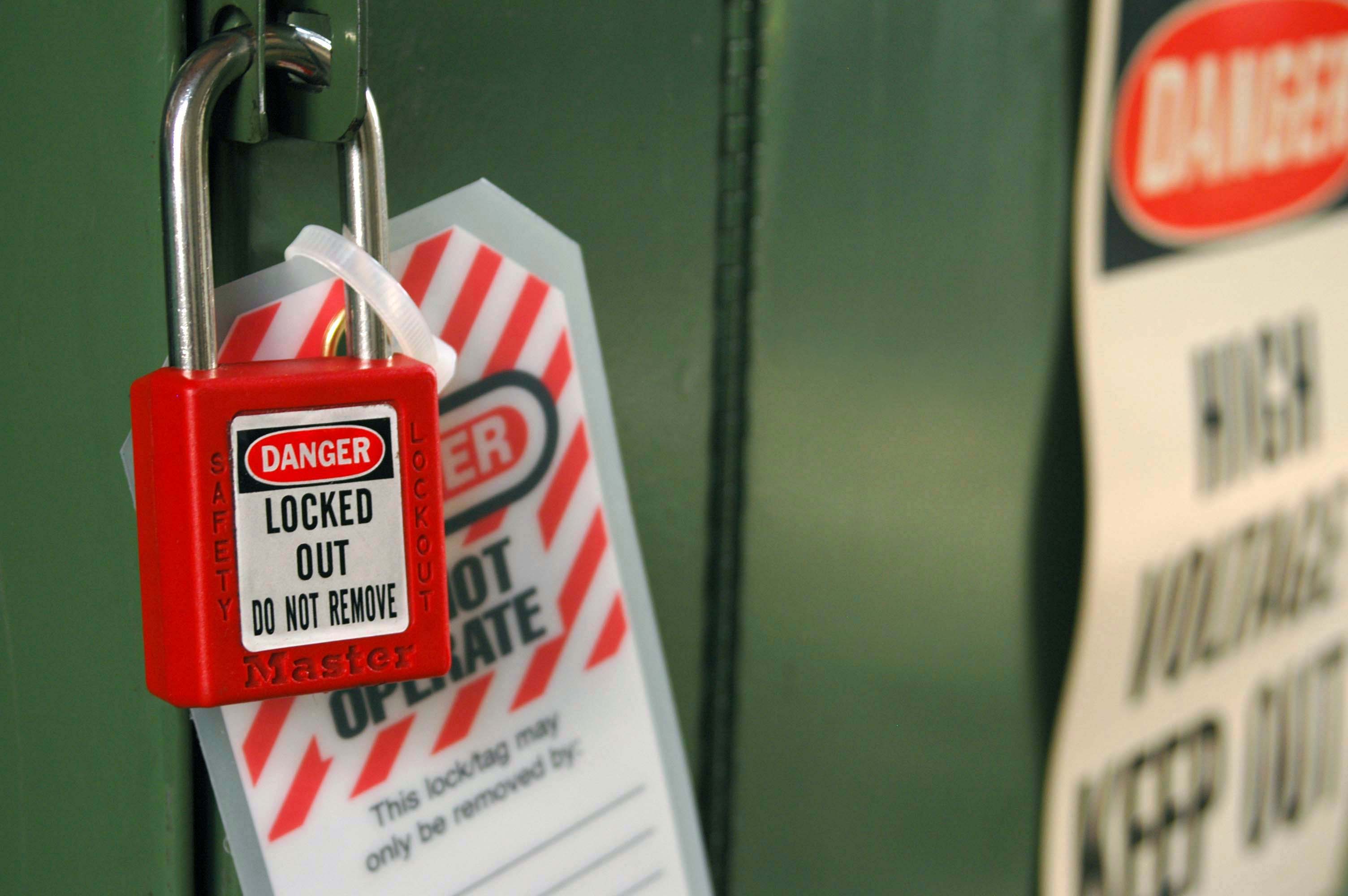MSHA Lock Out Tag Out Enforcement Update
More information has come out since last week’s MSHA Lock Out Tag Out emphasis announcement.
MSHA inspectors will focus heavily on locking out energy sources before performing any maintenance or repairs. In particular, MSHA singled out 1 mechanical lock out standard and three electrical lock out standards that will be emphasized:
Mechanical Lock Out
- 30 CFR §56/57.14105 – Procedures during repairs or maintenance
Electrical Lock Out
- 30 CFR §56/57.12006 – Distribution boxes
- 30 CFR §56/57.12016 – Work on electrically powered equipment
- 30 CFR §56/57.12017 – Work on power circuits
MSHA Lock Out Tag Out Inspections
There is only one way MSHA inspectors can check if a company is using proper lock out tag out procedures. When the MSHA inspector shows up (unannounced as always) he will go directly to the motor control center. If any maintenance is in progress he’ll be checking for:
- All energy sources isolated and locked out
- An individual lock for each person performing the maintenance
- A lock for which only one person has the key
- A tag with each person’s name and the date on each lock or
- One tag with the name of every person performing maintenance and the date
Isolating and locking out all energy sources seems to be the largest point of emphasis. In addition to what you’re working on, you must lock out any parts or machines or material that could potentially injure. For example, if you’re working on a cone crusher you must lock out the crusher itself. But you also need to lock out the belts going to and from the crusher. There’s a very good example of this in MSC’s Rules To Live By section which is available in our free trial.
Lock Out, Tag Out, Try Out – Every Time
In a great post, ISHN magazine outlined the most common problems with Lock Out Tag Out. Even after 16 years it’s spot on. I would only add one point. While “trying out” isn’t required by law, it is a best practice. You can’t truly know something is locked out until you’ve tried to turn it on and nothing happens. As MSHA pointed out in their announcement, “it’s not locked out until you’ve tried it out.”
Why do we try out? Our expert Kim Redding was recently consulting at a Cement plant where they needed to replace a belt. Every energy source to the conveyor was identified and locked out; not an easy task when there are over 5,000 breakers in one breaker box. The employees followed every regulation and protocol to the letter. But what happened when they tested their lock out? The belt turned on. Someone had mislabeled breaker, a mistake that seems small until someone’s life is on the line. We all know what could have happened if those workers hadn’t tested their lock out.
Including where you’re working, either the location or equipment, on tags is another best practice. You’re not required by law to include this information, but it’s a very good idea. It only takes a few extra seconds and could prevent a serious accident.
MSHA lock out tag out enforcement will increase in the coming months. Are you ready? To prepare, you can take our free Lock Out Tag Out module.
Lock Out Tag Out Procedures Will See Heightened Emphasis from MSHA in 2016
Lock Out Tag Out procedures have been an essential part of mine safety for years. This morning, Neal Merrifield of MSHA took the opportunity to reiterate “how important it is to develop and implement an effective mine-specific Lock – Tag – Try program.”
He goes on to say, “since 2005, 28 metal and nonmetal miners have died in accidents in which electrical power was not disconnected and locked out or other energy sources were not controlled before work was begun on power circuits or mechanical equipment.”
“MSHA standards require that before working on electrical circuits, power must be disconnected, switches locked out and warning notices posted and signed by those performing the work. In addition, power to machinery or equipment must be off and the machinery or equipment blocked against hazardous motion before beginning repairs or maintenance.”
Expect Increased Lock Out Tag Out Try Out Enforcement
“MSHA will stress the importance of concentrating on effective lockout procedures by focusing additional resources on increased enforcement and education and outreach, including walk-and-talks….Metal and Nonmetal inspectors and Educational Field and Small Mines Services personnel will be visiting mines, discussing safe work practices with miners and reminding everyone to maintain their focus on safety.”
Lock Out Tag Out Procedures Must be in Your Standard Operating Procedures.
Lock Out Tag Out Procedures should really be known as Lock Out Tag Out Try Out. No machine is truly tagged out until you have tried to turn it on and nothing happens. MSHA is re-emphasizing their effort to make sure every person on a mine tries out a machine before they consider it safe to conduct work. Lock Out Tag Out Try Out should be an integral part of every company’s standard operating procedures.
What This Means For 2016
As we all know, MSHA is much more inclined to increase enforcement and fines than to educate. I’ve discussed MSHA’s inclination to attribute decreased fatalities with the recent increase in fines.
Review your Lock Out Tag Out Try Out procedures. Do they need updating? Now would be a great time to focus a morning safety meeting or toolbox talk on LOTOTO.
Make sure you emphasize Lock Out Tag Out Try Out in your MSHA training this year.
Stay safe everyone.
Standard Operating Procedures
It’s the worst-case scenario. Someone has been injured at a job and your employees need help. But you’re working a mine on this job; a mine with multiple locations, different addresses with the same name and no Standard Operating Procedures to guide you.
Your workers have 911 on the line, ready to help. But they don’t know which site they’re on or how to get to their location. They have an injured man’s rescue at their beck and call but no way to help.
Sound far-fetched? This would never happen at one of your jobs? This unfortunate event happened to one of my contracting clients. 2 of their employees had 911 on the line. But instead of being able to assist in his rescue, they witnessed a man die of a heart attack right in front of them.
What could these contractors have done to prevent this tragedy? They needed directions to their location of the physical address of the mine site to get help from Emergency Services. Anyone in the company could have easily gotten this information by asking a few simple questions before they started work.
Is using a map app on your smart phone an option? That’s a risk I’m not willing to take. Many mines are in extremely remote areas. Reception can be spotty or non-existent. Why chance it when you can easily avoid a tragedy by asking 1 question?
Can’t 911 just track your phone’s GPS location like in a TV crime show? No, there are Federal privacy laws in place that prevent Emergency Response from accessing GPS information. If you can’t articulate your location, there’s nothing a 911 operator can do.
One advantage these contractors had was cell phone reception. But what if they didn’t? Would they have known where to get a signal? Or have another form of communication available like a CB radio?
Standard Operating Procedures, or SOPs, are a safety net in place for that worst-case scenario. So I need to ask; do you have standard operating procedures in place for your mine jobs? Do you have emergency procedures for each mine you service?
If you don’t you’re not alone. But these simple procedures on a checklist can save a life.
What are the standard operating procedures your company must have in place? I’ve designed a 3 page standard operating procedure template checklist available as a free download as part of our Contractor Success Kit.
There may be procedures that don’t apply to your company and that’s ok. This checklist is meant to be a starting point, a framework to build on. Designing standard operating procedures is about asking the right questions so you can be prepared if something does go wrong.
The worst-case scenarios may never happen, and we hope they never do. But if a tragedy does occur and you’re in a position to make a difference, don’t you want to be ready? You can. All it takes is a little time and thought to implement standard operating procedures at your company today.










